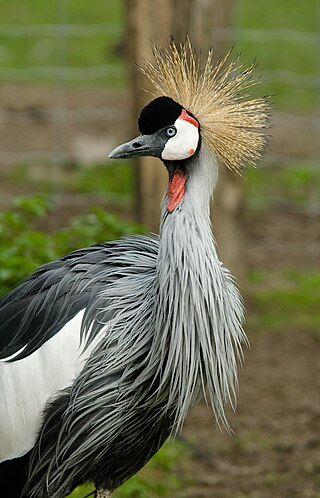
The Gruiformes are an order containing a considerable number of living and extinct bird families, with a widespread geographical diversity. Gruiform means "crane-like".

The magpie-robins or shamas are medium-sized insectivorous birds in the genus Copsychus. They were formerly in the thrush family Turdidae, but are now treated as part of the Old World flycatcher family Muscicapidae. They are garden- and forest-dwelling species found in Africa and Asia.

The Acrocephalus warblers are small, insectivorous passerine birds belonging to the genus Acrocephalus. Formerly in the paraphyletic Old World warbler assemblage, they are now separated as the namesake of the marsh and tree warbler family Acrocephalidae. They are sometimes called marsh warblers or reed warblers, but this invites confusion with marsh warbler and reed warbler proper, especially in North America, where it is common to use lower case for bird species.

John Edward Gray was a British zoologist. He was the elder brother of zoologist George Robert Gray and son of the pharmacologist and botanist Samuel Frederick Gray (1766–1828). The standard author abbreviation J.E.Gray is used to indicate this person as the author when citing a botanical name. The same is used for a zoological name.

Ampullariidae, whose members are commonly known as apple snails, is a family of large freshwater snails that includes the mystery snail species. They are aquatic gastropod mollusks with a gill and an operculum. These snails simultaneously have a gill and a lung as functional respiratory structures, which are separated by a division of the mantle cavity. This adaptation allows these animals to be amphibious. Species in this family are considered gonochoristic, meaning that each individual organism is either male or female.

Littorinimorpha is a large order of snails, gastropods, consisting primarily of sea snails, but also including some freshwater snails and land snails.

The Ophidiasteridae are a family of sea stars with about 30 genera. Occurring both in the Indo-Pacific and Atlantic Oceans, ophidiasterids are greatest in diversity in the Indo-Pacific. Many of the genera in this family exhibit brilliant colors and patterns, which sometimes can be attributed to aposematism and crypsis to protect themselves from predators. Some ophidiasterids possess remarkable powers of regeneration, enabling them to either reproduce asexually or to survive serious damage made by predators or forces of nature. Some species belonging to Linckia, Ophidiaster and Phataria shed single arms that regenerate the disc and the remaining rays to form a complete individual. Some of these also reproduce asexually by parthenogenesis.
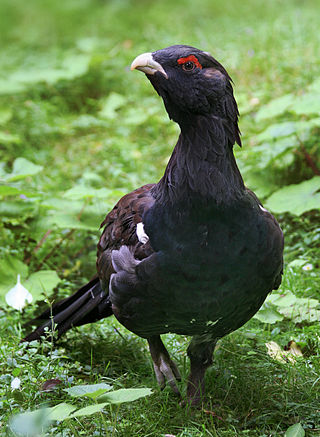
Tetrao is a genus of birds in the grouse subfamily known as capercaillies. They are some of the largest living grouse. Feathers from the bird were used to create the characteristic hat of the bersaglieri, an Italian ace infantry formation.

Calliostomatidae is a family of sea snails within the superfamily Trochoidea and the clade Vetigastropoda.

Phoenicircus is a genus of birds in the family Cotingidae. They have a bright red breast, crown, tail, and rump with the Guianan species having dark brown wings and the black-necked species having black wings. They are frugivores, eating primarily berries and drupes.

Siebenrockiella is a small genus of black marsh turtles. It used to be monotypic but now has two species with the addition of the Philippine forest turtle. The genus was originally erected in 1869 by John Edward Gray under the name Bellia, commemorating Thomas Bell, but this name is a junior homonym of Bellia Milne-Edwards, 1848, a crustacean genus. The replacement name, Siebenrockiella, was published in 1929 by Wassili Adolfovitch Lindholm, and commemorates Friedrich Siebenrock.
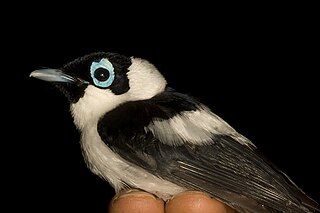
Arses is a genus of monarch flycatchers in the family Monarchidae. The genus is restricted to forest and second growth on the island of New Guinea, a few surrounding islands and northern Queensland, Australia. The genus is separated by their frilled necks, fleshy blue eye wattles and delicate pendent nests. They also have a distinctive foraging technique, hopping up tree trunks in a spiral fashion.

Tanygnathus is a genus of parrots in the Psittaculini tribe, of the superfamily of Psittacoidea.
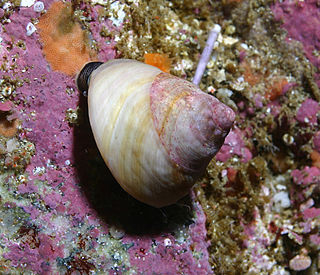
Trochoidea is a superfamily of small to very large vetigastropod sea snails with gills and an operculum. Species within this superfamily have nacre as the inner shell layer. The families within this superfamily include the Trochidae, the top snails. This superfamily is the largest vetigastropodan superfamily, containing more than 2,000 species.
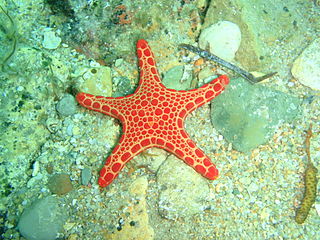
Goniasteridae constitute the largest family of sea stars, included in the order Valvatida. They are mostly deep-dwelling species, but the family also include several colorful shallow tropical species.

Ellobiidae, common name the hollow-shelled snails, is a family of small air-breathing land snails, terrestrial pulmonate gastropod mollusks in the clade Eupulmonata. Ellobiidae is the only family in the superfamily Ellobioidea, according to the taxonomy of the Gastropoda by Bouchet & Rocroi, 2005).
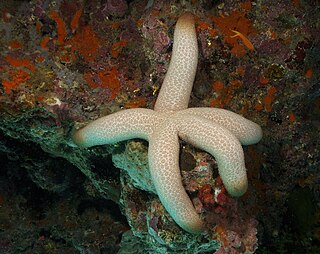
The Mithrodiidae is a family of starfish in the order Valvatida.

Fromia is a genus of starfish belonging to the family Goniasteridae.

Nepanthia is a genus of starfish of the family Asterinidae. Members of the genus have four to seven rays and are found in the eastern Pacific Ocean, ranging from Burma and Indonesia to Australia.




















